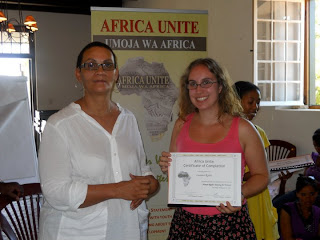One of the things that I will miss most about Cape Town is Thursday afternoons in Nyanga. I am so grateful to Siobhan for taking me to the community center there! Since then, Logan, Siobhan and I (and lately, a few others) have been venturing to Nyanga after class to play with the kids at their after school program. The program is run by Estelle, an amazing woman that works for Africa Unite. The centre is based out of an old church building and provides a safe environment for the kids to come to after school, receive a hot and nutritious meal (which, for many, is the only real meal of the day) and hang out with their friends, work on art projects, play sports, sing, dance, etc. A social worker is on the premises and holds sessions with different groups of the children and some of the older children work on drama performances.
Each week brings something different, but some of the favorite games are red light green light, duck duck goose and a version of freeze tag. The kids have also included us in a few singing and dancing group games. The songs are primarily in isiXhosa so I’m usually lost, but it’s always fun! The couple of weeks that I’ve forgotten to tie my hair back, I’ve ended up with my head adorned with a variety of braids. Another time, we brought nail polish and painted nails. One of the older girls, Noqolo has taught me a couple of fast-paced clapping games (similar but more complicated then Miss Mary Mac, for anyone who remember that one) and two of the younger girls have spent the past couple of weeks patiently teaching Brenna and I the dance moves to two traditional songs. We can judge our progress by the amount of giggling from our audience – less giggling means better dancing! The majority of the girls are excellent dancers, and several of them have beautiful singing voices. The two girls that primarily play the drums for the group are quite talented.
I am immensely impressed with the spirit of the children and the amount of talent that they have. The arts are an important part of the culture here. At the same time, the children make do with a lot less than the average American child in terms of toys and possessions and because of this, they find their fun from being with each other instead of playing video games, watching television or playing with the ‘latest and greatest’ new, overpriced toy on the market. The whole experience has made me find American materialism disturbing on a couple of different levels. First of all, American children miss out on a lot by always playing with things rather than spending time with people. Second of all, some of these wonderful South African children live in one room shacks with barely enough to eat while many people in America enjoy lives of abundant material excess. Of course, one doesn’t even have to go as far as America to see the harsh disparities. I doubt you would have to drive more than fifteen minutes out of Nyanga township to find people living lives of incredible privilege. It’s disgusting and has been one of the things that I’ve found the hardest to process here.















